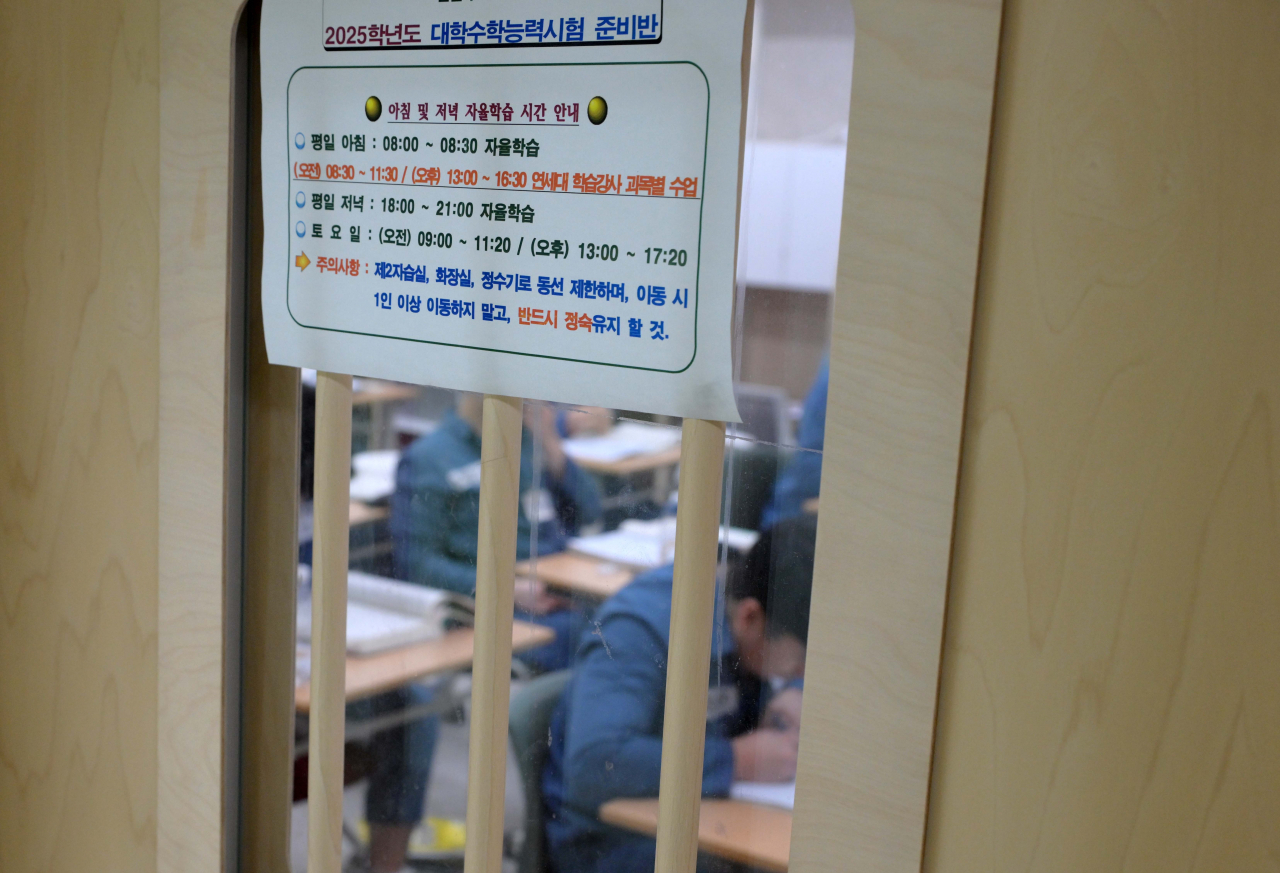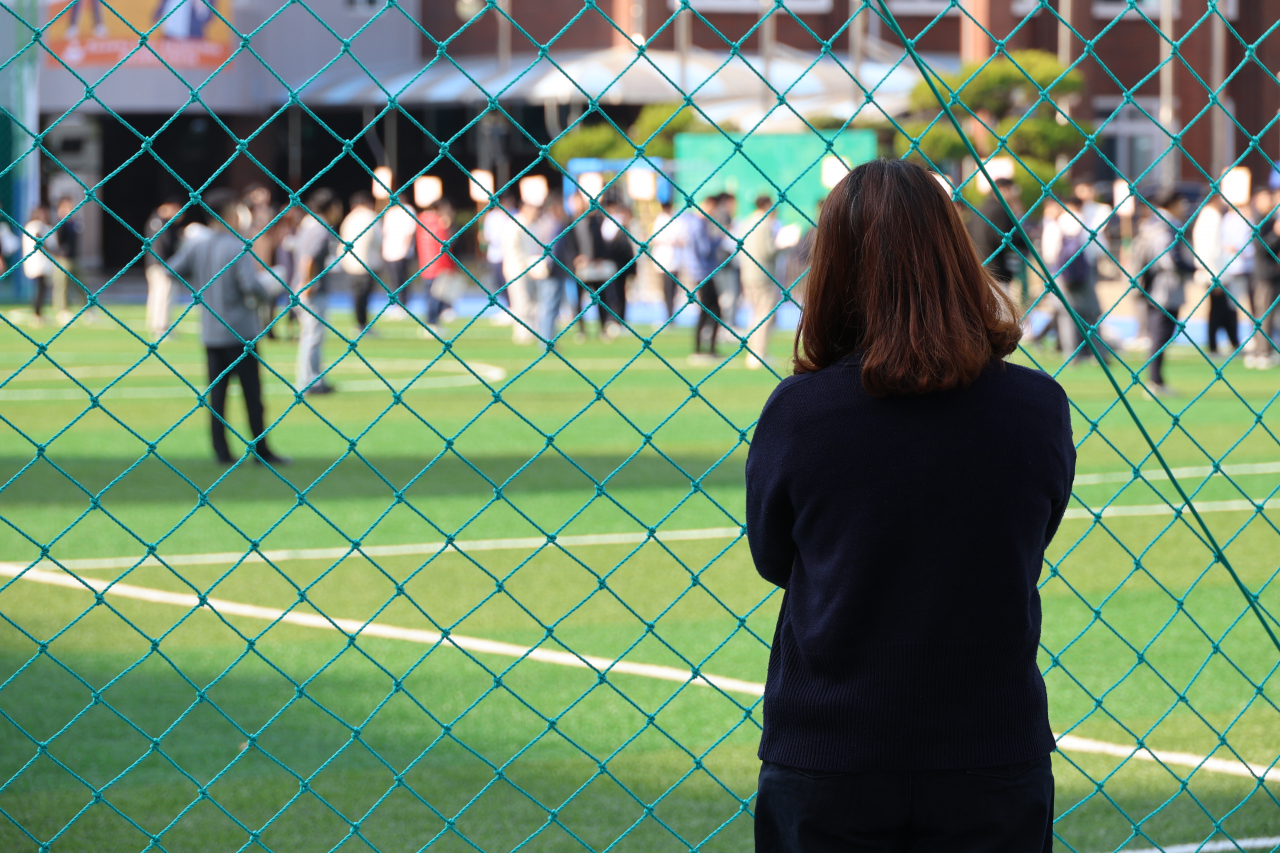On Thursday, more than half a million people across South Korea will converge at test sites to take what many view as a life-defining exam.
This is the Suneung -- the nation’s college scholastic ability test. Held just once a year, the nine-hour marathon determines the universities students will be able to attend, and from there, their career opportunities, future earnings and even relationships, as education holds an especially revered place in Korean society.
In November each year, South Korea effectively pauses for the Suneung; Shops close, banks shutter, the stock market delays its opening and even planes are grounded. For many, the test embodies dedication and sacrifice, symbolizing the nation's commitment to academic excellence.
But among this year's 520,000 test-takers, some are not motivated by prestige or competition, but by a lifeline -- a chance for a future beyond the walls of the country’s darkest space: prison.
 |
Boys in the CSAT prep class take a lesson at the Mandela Boys' School inside the Southern Correctional Institute of Seoul at Guro-gu, Seoul, on the afternoon of Nov. 8, just six days before the exam. (The Korea Herald/ Lee Sang-sub) |
Students in blue uniforms
“Have you memorized all the vocabulary?”
An English teacher starts class with a question for 12 boys in blue uniforms sitting at attention, their gaze fixed on the teacher.
Some of the boys nod, their eyes bright with eagerness that belies a desire to achieve something meaningful. Others, perhaps worn out from a restless night, confess sheepishly to having drifted off before finishing their work.
An ordinary scene in practically any classroom in Korea -- these students, however, are behind prison bars in their uniforms, each marked with an identification number stitched to their chests.
This classroom is inside Mandela Boys School, located within the Southern Correctional Institute of Seoul, where every lesson carries the weight of a potential second chance.
Inspired by Nelson Mandela's words, “The greatest glory in life is not in falling, but in rising every time we fall,” the school opened in March last year, becoming Korea’s first curriculum-based program within a correctional facility.
Here, 48 boys between the ages of 14 and 18 engage in regular classes, preparing for the Suneung and other qualifying exams, guided by the belief that education can prevent recidivism and offer a path to reformation.
Yeem Jin-ho, one of six dedicated teachers at the prison school, recalls his first days teaching here. “When I started, the hardest part wasn’t the material. It was giving these boys a reason to care, a purpose to study.”
Many of the students arrived with little sense of direction or hope, hardened by past mistakes and a lack of guidance. For them, thinking about the future -- about who they might become -- was a foreign concept.
Rather than diving straight into the syllabus, Yeem spent time helping the boys imagine new possibilities. He encouraged them to think about what they enjoyed, or what sparked even the smallest flicker of excitement. For the first time, many began to articulate dreams they never thought they could entertain, like becoming a firefighter, a chef or even a prison guard.
“The first lesson I wanted them to learn was that they could have a future worth working toward," Yeem quietly expressed. "The Suneung isn’t just an exam for them. It’s a symbol, a chance to rebuild their lives, one step at a time.”
Despite its intentions, the program has faced backlash.
Many argue that education and exams for offenders, especially those convicted of serious crimes, unfairly afford privileges to individuals who have harmed others.
However, educators stress that juvenile sentences in Korea last up to a maximum of 15 years. With many young offenders returning to society in their 20s or 30s, education offers a tangible way to prevent further crime.
“Mandela Boys School gives these young men not only knowledge, but a chance to reflect and build character, ensuring they rejoin society as positive contributors,” Yeem mused. “It’s a second chance, a win-win for everyone if it succeeds.”
To give these boys the chance, seven exam officers will be deployed on the day of the Suneung to the school.
 |
A mother watches her son from a distance as he attends a preliminary CSAT convocation at Chungnam High School in Seo-gu, Daejeon, South Korea, on Nov. 13, a day before the 2025 college entrance exam. (Yonhap) |
Tailored support
While the Suneung gives purpose to those whose paths have veered far from the norm, for some students with disabilities it stands as a testament to their resilience and their right to an equal chance at the future.
Despite the Suneung's strict prohibition of digital devices, some students will take the test with computers in front of them.
These are the severely visually impaired students who rely on Braille for their exams. For them, the Suneung unfolds not on paper, but through hundreds of pages of Braille -- each of them requiring careful focus and dexterity.
The students' fingertips glide over the raised dots of a 100-page questionnaire, the sheer volume of Braille text multiplying what is a manageable packet for most students into an exhaustive reading experience.
The time it takes them to complete these questions stretches far beyond the standard allotment; for some, this test can last up to 14 hours.
These students are not alone in their challenges. Students with a range of disabilities -- visual, auditory, motor and cognitive -- are given accommodations to provide a “fair” chance at the Suneung, recognizing that equality sometimes means adjusting the conditions.
Visually impaired students, for example, are allowed up to 70 percent longer than the standard testing time, and are provided with Braille, magnified text or spoken materials.
Students with motor impairments, such as those with brain lesions, also receive extended time, while others who struggle with control over their hands may have assistants who mark answers for them.
Students who have hearing impairments will be given the text scripts for the listening part of the exam while some will be allowed to participate with hearing aids.
Test takers who have tic disorders will have a mattress next to them throughout the exam. In extreme cases, parents of such students can wait on standby outside the classroom when security is otherwise stringent during the test.
“Our goal is simple,” explains an education official. “Everyone deserves a fair chance to take this test. Education is a basic right, and the Suneung represents the first step toward new opportunities.”
For some families, though, the impact of the Suneung extends beyond educational attainment.
“I don’t know if my son will go to college, but preparing for the Suneung has given him a reason to wake up and study every day,” shares a mother of a student with a brain lesion disorder.
For these students, the exam is not just a stepping-stone to the next stage of life -- it is a testament to the determination and resilience they have developed.
Despite facing hurdles that most could not imagine, they approach the exam with courage, driven by the same hopes and dreams as any other student.
“Life with disabilities is often challenging, and studying can be even harder because resources are limited,” shares a 19-year-old visually impaired student with the surname Kim. “The Suneung is one step in our journey, but real inclusion means continuing to improve accessibility, even after we enter college.”
As Kim articulates, the journey to fair education does not end with this momentous exam. The hope is that, through inclusion and equal opportunity, students of all backgrounds can explore their potential, both in school and beyond.







![[Herald Interview] How Gopizza got big in India](http://res.heraldm.com/phpwas/restmb_idxmake.php?idx=644&simg=/content/image/2024/11/20/20241120050057_0.jpg)